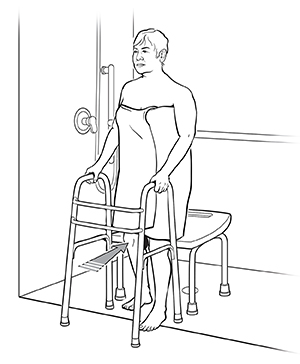Walkers: Bathing
Select a walker specially designed for wet environments. It should be made of materials that are durable, rust-resistant, and nonslip. Look for rubber tips at the ends of the legs of the walker. These will add stability on wet surfaces.
Note: Special shower chairs and tub benches are available. These chairs help you bathe safely. Ask your health care provider where you can get one. Make sure that your shower or tub chair is strong, stable, and nonslip.
Making your bathroom safe and accident-free
Try to make sure surfaces are dry before you walk on them. Nonskid mats can help prevent falls. Place them next to the bathtub and shower.
-
Use anti-skid material for the bathroom floor.
-
Install grab bars in your bathroom. They'll help you stay safe while getting in and out of the shower or bathtub.
-
Place your shower chair within reach of the grab bars.
-
Don't grab onto a towel bar. It's not like a grab bar and can break under the pressure.
-
Install scald-prevention devices. These devices will keep a check on the water temperature.
-
Choose impact-resistant shower and bathtub attachments.
-
Install bathroom door locks that can be unlocked from both sides.
-
Make sure you have adequate lighting.
Getting into a shower stall
1. Back up over the lip of the shower stall with your good leg until you feel the shower chair behind you. Reach back for the shower chair first with one hand, then the other, as you begin to sit down.

2. Lower yourself onto the chair. Lift each foot and turn to face the faucet and showerhead.

Getting into a tub
1. Back up until you feel the tub bench behind you. Reach back for the bench first with one hand, then the other, as you begin to sit down.

2. Lower yourself onto the bench and turn to face the faucet. Use your hands to help lift each leg over the side of the tub. A handheld showerhead can make bathing on a bench easier.
